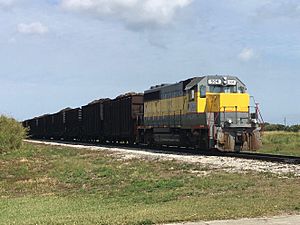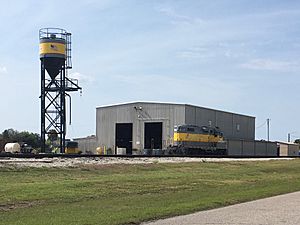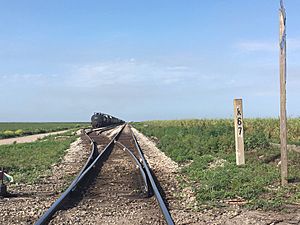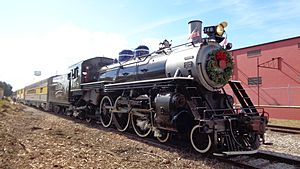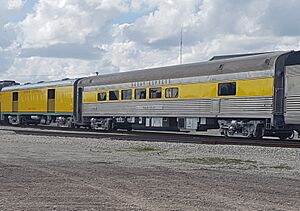South Central Florida Express facts for kids
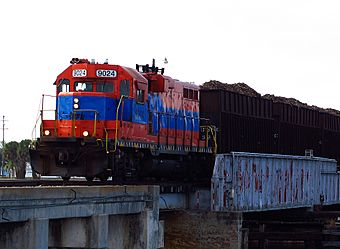
South Central Florida Express crossing Moore Haven Swing Bridge over the Caloosahatchee Canal
|
|
| Overview | |
|---|---|
| Headquarters | Clewiston, Florida |
| Reporting mark | SCXF |
| Locale | Southern Florida |
| Dates of operation | 1994– |
| Predecessor | Atlantic Coast Line Railroad CSX Transportation Florida East Coast Railway |
| Technical | |
| Track gauge | 4 ft 8 1⁄2 in (1,435 mm) standard gauge |
| Length | 171 miles (275 km) |
The South Central Florida Express, Inc. (SCXF) is a special kind of railroad in southern Florida. It's called a "shortline railroad" because it operates on a shorter network of tracks compared to big railroads. It's also a "common carrier," meaning it carries goods for many different customers.
This railroad is run by the U.S. Sugar Corporation. Its trains travel about 171 miles (275 km) from Sebring to Fort Pierce. They go around the southern part of Lake Okeechobee and serve many places. The SCXF is the biggest private farm-related railroad in the United States!
The SCXF started running trains in 1994 on tracks that used to belong to another company called CSX Transportation. Later, in 1998, it also started using tracks leased from the Florida East Coast Railway (FEC). U.S. Sugar also has its own private tracks, called the U.S. Sugar Railroad (USSC). These tracks connect to the SCXF lines. Since 2021, the SCXF has also run the Sugar Express, a special passenger train for tourists. It even has an old steam locomotive!
Contents
How the Trains Work
The South Central Florida Express (SCXF) is busiest during the sugar harvest season. This usually happens from October to March each year. U.S. Sugar is the only sugar company in the main part of the U.S. that uses trains to move its sugarcane.
Besides the SCXF, U.S. Sugar has its own private tracks, the U.S. Sugar Railroad. These tracks go from the SCXF lines right into the sugar fields near Clewiston and Bryant. Unlike the SCXF, the U.S. Sugar Railroad is just for U.S. Sugar's own use.
Sugarcane is cut from the fields around Lake Okeechobee. Then, it's loaded onto special rail cars. These "cane trains" take the sugarcane to U.S. Sugar's factory in Clewiston to be processed. After dropping off the full cars, the trains take the empty cars back to the fields.
On the east side of the lake, sugarcane is collected in the same way. The loaded cars go to Bryant Yard near Pahokee. There, many cars are joined together to make longer trains. These longer trains are then sent to Clewiston. This trip from Bryant to Clewiston is called the "Bryant Turn." During harvest time, these trains can run as often as every four hours!
After the sugar is made, products like sugar crystals and molasses are shipped out by train. They go to special connection points at each end of the line. From there, they are sent all over the United States. Chemicals needed to make sugar also arrive at the factory by train. The SCXF connects with CSX trains in Sebring and with Florida East Coast Railway (FEC) trains in Fort Pierce.
Train Engines
The South Central Florida Express uses many different train engines. They have several EMD GP11, GP38, and GP40 locomotives. They also have two larger SD40 series locomotives. U.S. Sugar also uses a few smaller switcher engines. To carry all the raw sugarcane, the SCXF and U.S. Sugar Railroad use about 800 special rail cars. Most of the train engines on both railroads have the "USSC" mark on them.
The Train Routes
The South Central Florida Express runs on 171 miles (275 km) of track. This makes it the biggest private farm-related railroad in the U.S. The SCXF owns the tracks between Sebring and Pahokee. It leases the tracks between Pahokee and Fort Pierce from the FEC. The main line is split into an east side and a west side. They connect at the Miami Canal in Lake Harbor.
West Side Route
The west side of the main line is about 82 miles (132 km) long. It starts in Sebring, where it connects with CSX tracks. A short distance south of Sebring is Desoto City Yard. This is a small yard where trains can switch tracks. CSX trains also use this yard to connect with SCXF trains.
From Desoto City, the line goes south, mostly next to US 27. It passes through Lake Placid and Palmdale. South of Palmdale, the line turns southeast towards Moore Haven. In Moore Haven, the line crosses the Caloosahatchee Canal on a small swing bridge.
The line continues southeast from Moore Haven, winding through sugar fields. It then reaches Clewiston. This is where U.S. Sugar's factory is located, right next to the SCXF's Clewiston Yard. The SCXF also has its maintenance building in Clewiston.
South of Clewiston, the line goes south and east through more sugar fields to a place called Keela. At Keela, the line splits. One part goes south and east to Okeelanta. The main line goes east from Keela to Lake Harbor, where it crosses the Miami Canal and connects with the east side.
West Side History
The northern part of the west side, between Sebring and Harrisburg, was built in 1916. It was part of a plan by the Atlantic Coast Line Railroad to extend its tracks south. The Atlantic Coast Line also built tracks to Moore Haven in 1918. In 1921, the Moore Haven & Clewiston Railway was built, extending the tracks to Clewiston. This line mostly served U.S. Sugar.
Over time, the Atlantic Coast Line became part of CSX by 1986. U.S. Sugar bought the west side tracks from CSX in 1994. Then, U.S. Sugar created the South Central Florida Express as a separate company to run these tracks.
East Side Route
The east side of the main line is about 71 miles (114 km) long. It continues the line from Lake Harbor east to South Bay. Then it goes north to Belle Glade, Pahokee, and Canal Point.
Near Pahokee and Canal Point is Bryant Yard. This yard is used to sort train cars and combine them from nearby sugar fields. The trains are then sent to Clewiston. Bryant Yard was next to the Bryant Sugar Mill, which closed in 2017.
The line crosses the St. Lucie Canal on a small lift bridge in Port Mayaca. The line then follows the lake for a short distance before turning northwest to a place called Marcy. The line crosses CSX tracks at Marcy. Then, it continues northeast directly to Fort Pierce, where it connects to the FEC.
East Side History
The Florida East Coast Railway (FEC) used to run the east side of this line. It was part of their Kissimmee Valley Line. This line reached Belle Glade by 1923 and connected to the Miami Canal in Lake Harbor in 1929. Most of the Kissimmee Valley Line was closed in 1947. The remaining track was connected to the FEC main line from Fort Pierce. The SCXF started leasing and operating this east side line from the FEC in 1998.
The Sugar Express
In 2016, U.S. Sugar got back a special steam locomotive, USSC No. 148. They had owned it before, from 1952 to the 1970s. This locomotive was originally used by the FEC on its Key West Extension. After three years of hard work to fix it up, No. 148 now runs on recycled vegetable oil! It pulled its first cane train in May 2020.
The South Central Florida Express now uses the No. 148 locomotive for the Sugar Express. This is a special tourist train for people to enjoy. U.S. Sugar also got an old train turntable from St. Louis, Missouri. This will be used to turn the No. 148 locomotive around in Clewiston.
For the Sugar Express, U.S. Sugar got some cool old passenger cars. They have a lounge car called Palmdale and an open-air car called Miami Locks. They also got three more passenger cars and another observation car. All these cars will be painted to look like the old City of Miami train. U.S. Sugar also bought another steam locomotive, Atlantic Coast Line 1504. It will join the Sugar Express after it's fixed up.
On December 12, 2021, the Sugar Express made its first public trip! The No. 148 locomotive pulled the Lake Placid Limited train from Clewiston to Lake Placid and back. The Sugar Express now runs many events, including special holiday trains and trips around the Lake Okeechobee area.


